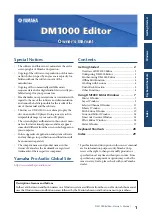
Event Types for Alarms
EPICenter Reference Guide
530
MSM Failover Occurred
Extreme Networks proprietary trap. An MSM Failover occurred.
ExtremeXOS 10.1
Main Power Usage Off
Indicates the PSE Threshold usage indication off, the usage
power is below the threshold. At least 500 msec must elapse
between notifications being emitted by the same object
instance.
ExtremeXOS 11.1
Main Power Usage On
Indicates the PSE threshold usage indication is on, and the
usage power is above the threshold. At least 500 msec must
elapse between notifications being emitted by the same object
instance.
ExtremeXOS 11.1
Netlogin
Authentication Failure
Extreme Networks proprietary trap. Generated upon
authentication failure for a netlogin supplicant.
Not supported in
ExtremeXOS
Netlogin User Login
Extreme Networks proprietary trap. Generated when a netlogin
supplicant passes authentication and logs in successfully into
the network.
Not supported in
ExtremeXOS
Netlogin User Logout
Extreme Networks proprietary trap. Generated when an
authenticated and logged in netlogin supplicant logs out.
Not supported in
ExtremeXOS
OSPF Interface
Authentication Failure
An ospfIfAuthFailure trap signifies that a packet has been
received on a non-virtual interface from a router whose
authentication key or authentication type conflicts with this
router’s authentication key or authentication type.
ExtremeWare 6.1.9
ExtremeXOS 10.1
OSPF Interface Config
Error
An ospfIfConfigError trap signifies that a packet has been
received on a non-virtual interface from a router whose
configuration parameters conflict with this router’s configuration
parameters. Note that the event optionMismatch should cause a
trap only if it prevents an adjacency from forming.
ExtremeWare 6.1.9
ExtremeXOS 10.1
OSPF Interface
Receive Bad Packet
An ospfIfRxBadPacket trap signifies that an OSPF packet has
been received on a non-virtual interface that cannot be parsed.
ExtremeWare 6.1.9
ExtremeXOS 10.1
OSPF Interface State
Change
An ospfIfStateChange trap signifies that there has been a
change in the state of a non-virtual OSPF interface. This trap
should be generated when the interface state regresses (e.g.,
goes from Dr to Down) or progresses to a terminal state (i.e.,
Point-to-Point, DR Other, Dr, or Backup).
ExtremeWare 6.1.9
ExtremeXOS 10.1
OSPF LSDB
Approaching Overflow
An ospfLsdbApproachingOverflow trap signifies that the number
of LSAs in the router’s link-state database has exceeded ninety
percent of ospfExtLsdbLimit.
ExtremeWare 6.1.9
ExtremeXOS 10.1
OSPF LSDB Overflow
An ospfLsdbOverflow trap signifies that the number of LSAs in
the router’s link-state database has exceeded ospfExtLsdbLimit.
ExtremeWare 6.1.9
ExtremeXOS 10.1
OSPF Max_Age LSA
An ospfMaxAgeLsa trap signifies that one of the LSA in the
router’s link-state database has aged to MaxAge.
ExtremeWare 6.1.9
ExtremeXOS 10.1
OSPF Neighbor State
Change
An ospfNbrStateChange trap signifies that there has been a
change in the state of a non- virtual OSPF neighbor. This trap
should be generated when the neighbor state regresses (e.g.,
goes from Attempt or Full to 1-Way or Down) or progresses to a
terminal state (e.g., 2-Way or Full). When an neighbor
transitions from or to Full on non-broadcast multi-access and
broadcast networks, the trap should be generated by the
designated router. A designated router transitioned to Down will
be noted by ospfIfStateChange.
ExtremeWare 6.1.9
ExtremeXOS 10.1
Table 58: SNMP Trap Events (continued)
Event
Definition
ExtremeWare/
ExtremeXOS
Version
Summary of Contents for EPICenter 6.0
Page 14: ...EPICenter Reference Guide 14 ...
Page 18: ...Preface EPICenter Reference Guide 18 ...
Page 19: ...1 EPICenter Basic Features ...
Page 20: ......
Page 24: ...EPICenter Overview EPICenter Reference Guide 24 ...
Page 44: ...Getting Started with EPICenter EPICenter Reference Guide 44 ...
Page 100: ...The Inventory Manager EPICenter Reference Guide 100 ...
Page 140: ...The EPICenter Alarm System EPICenter Reference Guide 140 ...
Page 172: ...Configuration Manager EPICenter Reference Guide 172 ...
Page 196: ...The Firmware Manager EPICenter Reference Guide 196 ...
Page 220: ...The Interactive Telnet Feature EPICenter Reference Guide 220 ...
Page 250: ...The Grouping Manager EPICenter Reference Guide 250 ...
Page 276: ...Real Time Statistics EPICenter Reference Guide 276 ...
Page 342: ...Using the VLAN Manager EPICenter Reference Guide 342 ...
Page 348: ...The ESRP Monitor EPICenter Reference Guide 348 ...
Page 446: ...EPICenter Reports EPICenter Reference Guide 446 ...
Page 447: ...2 Advanced Upgrade Features ...
Page 448: ......
Page 480: ...EAPS Protocol Monitoring and Verification EPICenter Reference Guide 480 ...
Page 508: ...Using the Policy Manager EPICenter Reference Guide 508 ...
Page 525: ...3 Appendices ...
Page 526: ......
Page 542: ...EPICenter Backup EPICenter Reference Guide 542 ...
Page 564: ...Voice over IP Manager EPICenter Reference Guide 564 ...
Page 580: ...EPICenter Reference Guide 580 ...
















































